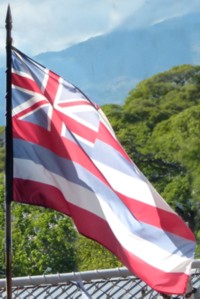Treaty of Reciprocity
The planters had a plan: a Treaty of Reciprocity between the United States of America and the Hawaiian Kingdom was drafted under which Hawaiian sugar and other goods would enter the US duty free. In return US goods would enter Hawaii free and, as a sweetener, the US Navy could build a naval base in the mouth of the Pearl River.
This would be a win-win for the planters, who saw a political advantage in a physical US presence, but not so good for the Hawaiians who were outraged at a proposed alienation of sacred Hawaiian river lands. The Hawaiians still held the overwhelming balance of power in the democratically elected House of Representatives. With the growing racial tensions fist-fighting broke out on the floor of the Legislature.
Kamehameha V acceded to the proposed Treaty of Reciprocity but it would not pass the lower house. Shortly afterwards in, 1872, the he died without leaving an heir.
A new King, Lunalillo, was chosen by popular vote of the Hawaiian Legislature. He was a sophisticate and lover of the arts who also 'liked a drink'. He was also dying of Tuberculosis and would last little over a year. His reign was chaotic. Helped along by the Missionary Party lawlessness had broken out across the country and the royal household troops, who were commanded by Europeans, mutinied and were disbanded.
An attempt by Queen Emma to rule and restore order was thwarted by the Legislature and the House of Nobles elected another high-cast Hawaiian: King Kalakaua.
Kalakaua became known as the 'Merry Monarch'. He demanded an elaborate coronation, reflecting that of Napoleon, and built the large 'loani Palace for balls and State banquets. Yet he entertained friends and visitors, like Robert Louis Stevenson, in his more casual wooden boat house in the traditional style preferred by his Queen.
King Kalakaua entertaining Robert Louis Stevenson in his Boat House
They're sitting on the floor but women alternate with men and the dress style is European
Edwin J. Beinecke Collection of Robert Louis Stevenson - public domain
The glittering 'loani Palace is now a tourist attraction.
During his reign Kalakaua negotiated a more limited Reciprocity Treaty under which only Ford Island (moku'ume'ume) in the middle of the river would be leased to the US for 'a coaling and repair station for the use of vessels of the United States, and to that end the United States may improve the entrance to said harbor and do all other things needful to the purpose aforesaid.' - ratified in 1884. Read more...
This together with his taste for power and a plan to create a Federation of Polynesia so alarmed the Missionary Party that they forced the 'Bayonet Constitution' of 1887 on him by threatening him with the militia, now commanded by their supporters. This robbed Kalakaua of most of his powers. For good measure the new constitution abolished the democratically elected House of Representatives and restructured the House of Nobles so that only wealthy land owners and US citizens, now made honorary Hawaiians, could stand as members. Once in effective control of the government they worked to replace Kalakaua with his sister, princess Lili'uokalani, as Regent.
Dredging at Pearl Harbour after 1884 - resulting from the Reciprocity Treaty of 1875
Note that the attached commentary at the US Army Museum is misleading as to dates and extent
Kalakaua died of a stroke in San Francisco in 1891 and Lili'uokalani returned from London, where she was attending Queen Victoria's Jubilee, to be crowned. As Queen her first goal was to restore democracy but this was not to be tolerated by the white businessmen who had sized power and were now actively lobbying Washington for the annexation of Hawaii by the United States. The Hawaiian public were close to rebellion so the white minority formed a 'Committee of Public Safety' and strengthened the militia to assure the 'safety' of families and property.

